I Just heard that one of the auto agencies that we had “saved” in late 2015 from going mostly Digital/TV at the Media Director level, just did so, cutting out their radio. The job of getting these dollars back now will not be easy due to a number of reasons, not the least of which the owner of the agency who made this decision, doesn’t want to appear foolish and will defend his decision.
This speaks to the importance of a couple of things. First, getting to the real key decision maker at the agency (the Media Director clearly didn’t have the long term juice), covering off any “red flags”, making sure they are “sold” as well as educating the key dealer contact to the point that they too are “sold”. It also speaks to the importance of having Polk auto sales data that paints a dealer-by-dealer picture of YTD 2016 and 2015 sales, enabling us to more effectively to defend Radio’s importance to the media mix if a) the dealership is outperforming other dealerships in the market and b) sales are up “X” percent. Both of which we believe is true based upon recent comments by the dealership’s GM but can’t quantify.
It would be wise for all who handle auto accounts to quickly get in front of the key decision maker’s at the dealership and agency and begin to re-sell them on the Radio medium.
Hopefully you’ll find some of the information below helpful in making the “Radio case”.
This week Tracey Scheppach, EVP Precision Video at Starcom Media Group was quoted as saying in Ad Age, discussing addressable TV ads, “The mistake many people made is we raced to the bottom of the sales funnel.”
The Internet typically is best at siphoning demand, not creating it or even getting a product into a consumer’s consideration set. The Internet “works” because it targets the very bottom of the purchasing funnel- those ready to buy. What should be a concern, is that while cost effective, it doesn’t create or increase consumer demand- it simply harvests it.
This is a point we need to continually highlight. Before I can buy your car or visit your dealership, I have to at least “consider” buying or visiting it and to “consider” buying or visiting it, I have to know something about it which means it needs to be branded in some form or fashion- not a strength of Digital. Think back to your last car purchase? How many manufacturers did you consider? Those not under consideration stood zero chance of being purchased and were probably completely ignored online. It’s all about getting into a consideration set and this is a key strength of Radio’s.
We are in the midst of running a Clip Interactive survey in a top 30 market to uncover auto insights, several of which are below and based upon over 200 consumer responses. The first insight illustrates that the Internet doesn’t set the world on fire and that dealerships and agencies might be a bit blinded by the Digital glare and in need of some traditional sunglasses (scale of 1-10):
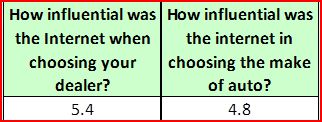
The second insight was that while “price” is important, it is not the most important reason for choosing a dealership. Can Digital communicate “Honesty” and “Friendly” as effectively as Radio? We don’t think so:

We also need to stress Radio’s continued importance to the consumer. This slide can help make this point. It was highlighted last week and derived from USA TouchPoint data:
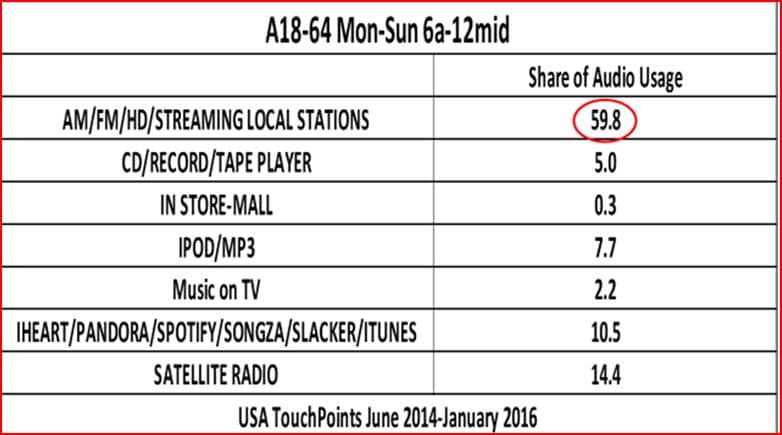
We also understand that consumers are visiting fewer showrooms and making purchasing decisions more quickly and that the traditional path to purchase it out the window, but more sales are lost due to not even being considered than all other reasons for not buying combined. Radio gets your dealership “considered”. The attached Nielsen study supports this statement.
This weekend there will be “X” number of cars sold in a market. Any car salesperson worth their weight in salt wants to have the last opportunity to have the last word with a prospect to communicate one more reason to buy from “me” and not them. Radio enables a dealership to get that last “word” before they sign elsewhere and are off the grid for 5 years. This is another area where Radio shines- enabling a dealership to differentiate itself from the others and providing reasons to buy/visit such as “honesty”, having a “great service center” and “friendliness”, beyond “price”.
The following chart was derived from the latest USA TouchPoints data. One of TouchPoints key benefits is being able to illustrate Radio’s ability to communicate a timely message when a product is being “purchased”, “considered” or “decided” upon.
This chart highlights media share of usage when a 25-64 adult consumer is “considering, purchasing or deciding” on an “automotive” product and while “automotive” includes the purchasing, considering or deciding upon which auto to purchase, this category does include auto parts and other auto related services.
Yet, it does confirm Radio’s ability to communicate a message at the “automotive” Zero Moment of Truth (ZMOT) – when an ad would be most relevant and impactful.
This chart is to be read as: Radio’s has a 33.3% share of media usage in the same half hour that an A25-64 was deciding, considering or purchasing an “automotive” product.
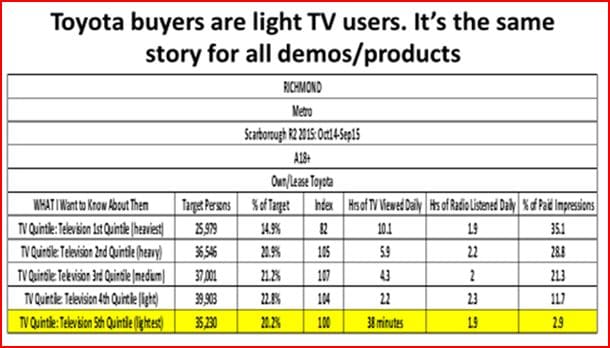
In the article referenced above, Scheppach also went on to say, “Marketers can reach about 65% of consumers pretty easily with standard TV buys, but finding light TV watchers is tough and only getting harder with audience fragmentation.” Not if you use Radio.
The following slide is one we presented to an agency earlier this week that handles the Toyota Dealer Association which confirms Scheppach’s observation about TV not being able to effectively cover the “entire market”.
This chart highlights that 20% of current Toyota owners in this market view TV only 38 minutes/day (lightest viewers) and would be exposed to less than 3% of Toyota’s paid gross impressions. These same lightest TV viewers listen to Radio close to 2 hours/day.
The key takeaway-Radio effectively covers these light TV viewers.
On top of this, the least affluent of these viewers, those who comprise less than 15% of all Toyota owners (and watch TV 10 hours/day), will be exposed to 35% of Toyota’s paid gross impressions. This is not a “use Radio if there’s any extra dollars” discussion, it is a “use Radio to make your media campaign more effective” discussion. Reaching “more” with a relevant message is preferable to repeatedly “preaching to a few”, the heaviest of TV viewers.
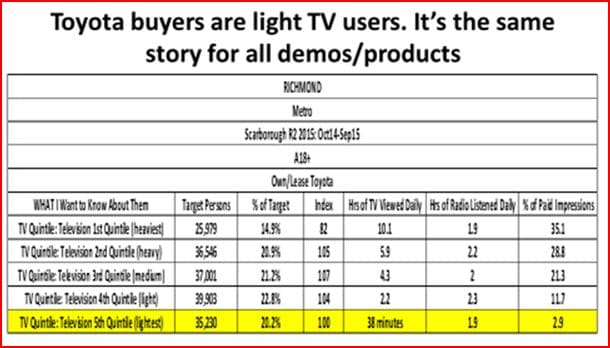
There are also several slides from the recent ARF study that could be helpful when meeting with dealers and their agencies. The ARF (Advertising Research Foundation) is the research equivalent of the Good Housekeeping Seal of Approval. The biggest marketers in the world were involved with the creation of these slides and the following conclusions:
The more mediums utilized in a media campaign, the greater the return-on-investment. These results are based upon 3,200 sophisticated econometric analyses by one of the industry’s most respected econometric firms, Analytic Partners. This is not chipmunk research. Use TV, use the Internet, but do not ignore Radio. The reasons to use Radio go far beyond Radio’s TSL and speaks to Radio’s ability to deliver a message to the light consumers of different media in different “contexts”, where other media can’t go and at key moments of receptivity.
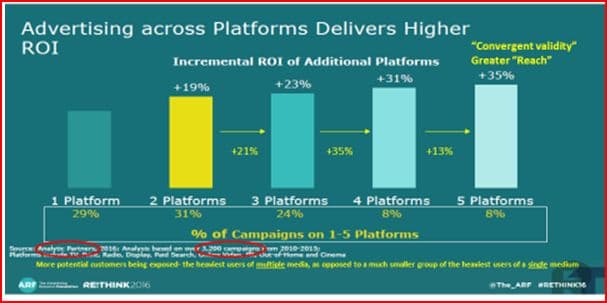
The slide below details the results of another much respected analytics company, Marketing Evolution, which analyzed $100 billion in ad spend over the past 5 years. Their conclusion: Digital expenditures need to be kept in perspective, that while it needs to be part of the plan, it should not the majority of the plan. Their suggested Digital allocation: 20%-30%. If a dealership is interested in maximizing sales they’d be wise to keep this finding in mind. Plus, we can help them with the Digital component of their media plan.
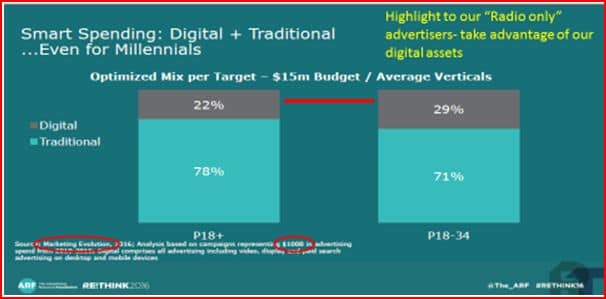
The ARF study also concluded there is a point-of-diminishing returns. Truth is there is a point of diminishing returns to everything no matter how good or effective it might be at the outset. It what’s referred to as “satiation”. The first beer tastes the best, then it goes downhill from there. Sometimes too far downhill.
Same is true with media impressions. The first impression is most effective, then each successive impression gets increasingly less effective- this is a life law not just a media law. There does come a point when even if a particular medium isn’t deemed to be as effective as another one initially, it will at some point generate a greater return-on-investment due to the over-use of the initial medium. Anything “good” can become “bad” if it’s overdone; exercise, eating, work and even the use of TV or Digital.
Excessive use of any medium results in less impact per ad dollar. We had made this point to an agency earlier this week, highlighting that they placed 6,000 TV commercials in one market in Q1 2016. Media Monitors is a great way to effectively make this point. It’s difficult to understand how this might not be perceived as being too much of a good thing on TV. Our discussions with this agency and client are ongoing:
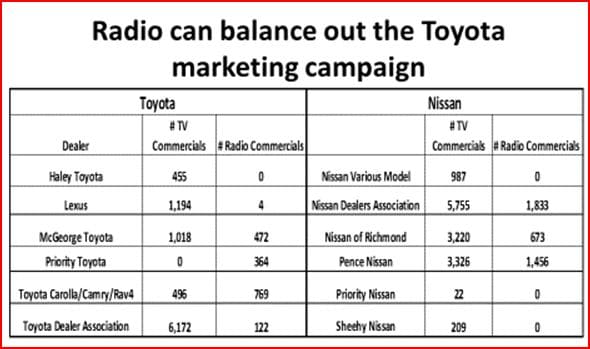
Also, why should a dealership continue to pay premium dollars for TV, which due to multi-tasking, has largely become an audio advertising medium sprinkled with occasional visual elements? The ARF study concluded that viewer’s eyes are not on the TV screen but are facing downward up to 65% of the time. This should surprise no one:
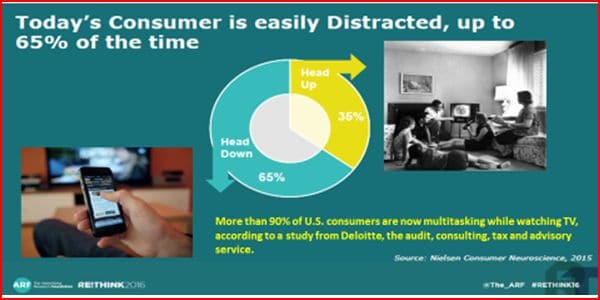
If this is “too high level” stuff for the dealers or their agencies, try positioning Radio’s role in the following manner:
– Complementary Medium: Radio not only delivers media value on its own but also reaches the light users of other media, leaving no potential customer “uncovered”. The auto business is too competitive to leave any potential customer “uncovered”.
– Resonance: Radio’s efficiency enables an advertiser to maintain “continued brand presence” as well as being a powerful memory maintenance vehicle, extending the life of any TV campaign. When it comes to marketing, out of sight really is out of mind. Radio enables a dealership to maintain critical visibility. Car buying never stops and as such nor should dealership advertising.
– Magnification: Enables a dealership to communicate “other reasons” to buy/believe beyond price (reference the Clip study above- or even better, do your own). This is often referred to as “convergent validity”- heard the messaging elsewhere so must be true. The ARF study confirmed that there is a considerable amount of positive “priming” impact between Radio and TV. Radio making the TV advertising more effective and TV making the Radio advertising more effective.
– Acceleration: The longer a campaign runs the more effective the campaign becomes. “Being there” when an auto shopper is deciding is the difference between a sale this weekend and lost business. The absent are always wrong in sales and in the auto dealership business.
– Synergy: The same number of exposures in multiple media are more effective than the same number of exposures in a single medium. Multiple media have a greater “summed” effect than any individual media.
Bob McCurdy spent many years as a national and local sales executive who now oversees radio sales consultancy at called uppingthevolume. He can be reached at [email protected]





